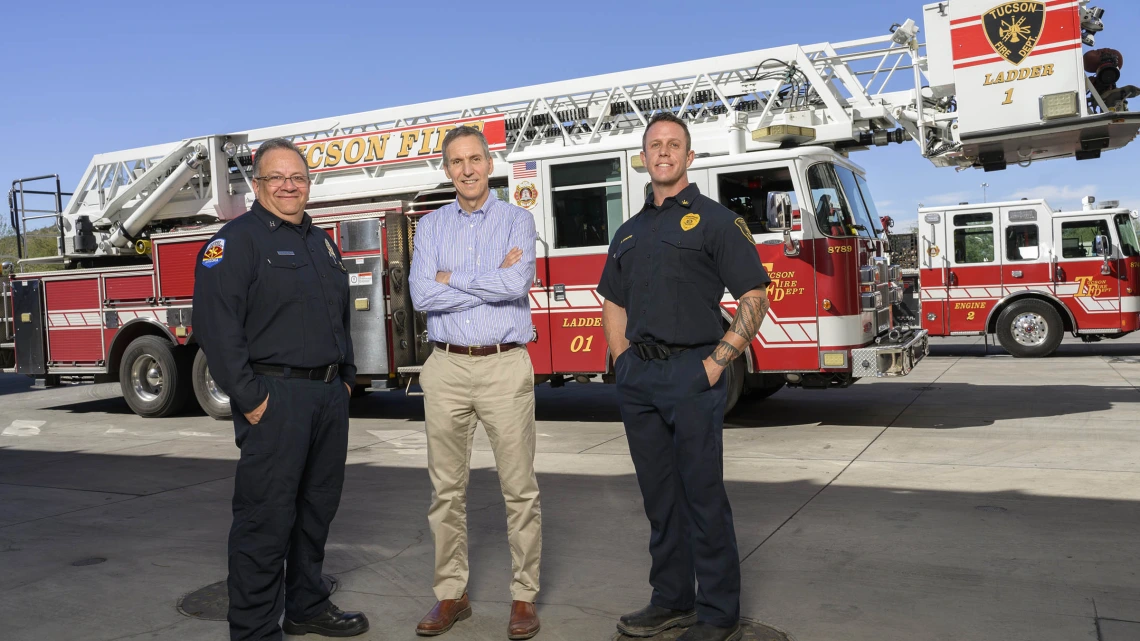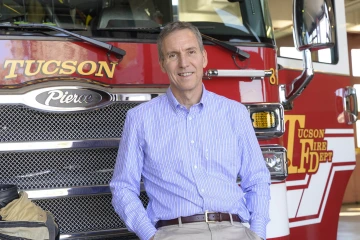Improving Firefighter Health Through Research
Dr. Jeff Burgess’ love of teamwork and adventure led to a career following his passion for making firefighting a healthier and safer occupation for all.

(From left) Tucson Fire Capt. John Gulotta, professor Jeff Burgess, MD, MS, MPH, and Chief Paul Moore have worked closely for 30 years to help reduce risks to firefighter health in Tucson and around the globe.
In another life, Jeff Burgess, MD, MS, MPH, might have been a foreign service officer in some exotic locale or a forest ranger, where outdoor adventures awaited. Instead, he chose a career in medicine and public health.
Almost from the get-go, Dr. Burgess, a professor at the University of Arizona Mel and Enid Zuckerman College of Public Health who is also a member of the UArizona Cancer Center, has served as an advocate for firefighter health and safety. For the past 30 years, he has teamed with the Tucson Fire Department on research benefiting firefighters worldwide.
“The unique piece about Dr. Burgess and his research is it’s collaborative,” said Tucson Fire’s Capt. John Gulotta. “Whether it’s a product manufacturer or a researcher, often what they do is guess, ‘We think this is what the fire service wants.’ And what happens is they get close, but there’s always something missing. Dr. Burgess has always involved the fire service first. We sit down together. We talk about everything well in advance. What is it the fire service wants?”
Health risks of occupational exposures
Dr. Burgess’ work with firefighters began while he was completing a medical toxicology fellowship at the UArizona College of Medicine – Tucson and a master’s degree in toxicology at what is now the R. Ken Coit College of Pharmacy. An industrial hygiene class he took convinced him to get the master’s degree to learn more about occupational exposures.

Tucson Fire Department Captain John Gulotta said he appreciates the way Jeff Burgess, MD, MS, MPH, doesn’t just tell firefighters what is right for them, he actively engages the first responders in his research.
Afterward, Dr. Burgess returned to the University of Washington in Seattle, where he earned his medical degree, for an occupational and environmental medicine fellowship and a master’s in public health degree on environmental health. While there, he was awarded a federal grant to set up a hazardous material exposure service at the Washington Poison Center.
“With that, I was giving information to firefighters responding to hazmat events so they had guidance on what to expect from exposures they might face,” Dr. Burgess said. “Were they or people they rescued from a hazmat incident in danger or not? The default was to transport them to the emergency room. But, if you use industrial hygiene principles and know the type of exposures people have, you can say, ‘Well this person is at risk,’ or ‘This person is not.’”
That allowed firefighters and paramedics to make better decisions on the scene by receiving instant feedback. That feedback lowered the number of transports to hospital emergency departments and reduced the burden on emergency resources, which often are more costly than outpatient visits for follow-up care.
Collaborating to improve health
Dr. Burgess joined the UArizona Health Sciences faculty in 1997 and began responding to more and more fire service questions.
The Phoenix Fire Department, for example, wanted to know how much exposure firefighters had in the overhaul stage when they’re checking if a fire is fully extinguished. An initial study led by Dawn Bolstad-Johnson, MPH, then a Phoenix Fire industrial hygienist and graduate student with Dr. Burgess, identified concerning levels of toxic exposure. A follow-on study showed air-purifying respirators weren’t protective enough, so it was recommended firefighters continue using self-contained breathing apparatuses with compressed air tanks for overhaul response.

Jeff Burgess, MD, MS, MPH, has spent most of his career helping firefighters.
“That literally changed how fire stations are built. We no longer have carpet. We no longer have fabrics. Everything is washable. Everything is nonporous,” Gulotta said.
Things picked up rapidly for Dr. Burgess from there, with multiple studies funded by the National Institute of Occupational Health and Federal Emergency Management Agency allowing him and his team to work collaboratively with Tucson Fire and other fire service organizations.
In 2016, he received a federal grant with other universities, multiple fire departments and other fire service organizations to establish the Firefighter Cancer Cohort Study, which now has expanded to include over 3,200 firefighters and more than 50 fire departments across 26 states. He has produced or appeared in many podcasts and YouTube videos extolling on the latest findings from the study, which examines toxic exposures to determine which ones lead to increased cancer rates in firefighters and evaluates the effectiveness of exposure-reduction interventions.
Firefighters around the globe have benefited from Dr. Burgess’ investigations into the health risks associated with chemicals released in a fire. Such chemicals, including “forever” ones like per- and polyfluoroalkyl substances or PFAS, create health hazards for firefighters, whether inhaled or absorbed through the skin.
In 2020, Dr. Burgess’ research expanded to include the long-term health effects of COVID-19 on first responders and essential workers as part of the Arizona Healthcare, Emergency Response and Other Essential Workers Surveillance (AZ HEROES) study. This work started with firefighters and then led to all essential and frontline workers and now children, said Dr. Burgess, who leads the interdisciplinary AZ HEROES research team.
“We don't just give him ideas. We partner with him. We show up at meetings at his lab, and all his lab people come and do ride-alongs with us.”
Capt. John Gulotta, Tucson Fire Department
This past summer, he participated in an International Agency for Research on Cancer meeting in Lyon, France, that led the World Health Organization agency to classify occupational exposures as a firefighter as carcinogenic.
In October, Dr. Burgess received a $1.5 million federal grant for ongoing research on toxicity of exposures for women firefighters. And in November, the Arizona Board of Regents awarded him a $4 million Regents Research Grant to examine ways to cut firefighter cancer and cardiovascular risks. That collaboration will include fire departments throughout Arizona, as well as other researchers at UArizona Health Sciences and Arizona State University.
Most recently, Dr. Burgess is building the Zuckerman College of Public Health’s new Center for Firefighter Health Collaborative Research along with co-directors and fellow faculty members Kate Ellingson, PhD, Leslie Farland, ScD, MSc, Melissa Furlong, PhD, Patricia Haynes, PhD, CBSM, and Yiwen Liu, PhD. Fire service partners will play an integral role at the center, Dr. Burgess said.
Firefighters say they appreciate Dr. Burgess and his research team’s openness to their input on issues affecting their health. It’s a matter of working side by side.
“We don't just give him ideas. We partner with him,” Gulotta said. “We show up at meetings at his lab, and all his lab people come and do ride-alongs with us. So when they do the research, it's not just a bar graph with some dots. Those dots actually represent firefighters. That makes the research much more meaningful.”

